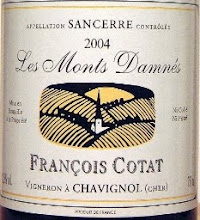As soon as we decided to do Riesling, one thing came to mind. No it was not Mosel or petrol or acidity...it was choucroute!! Hell yeah !
Yeah yeah, ok I will also talk about the wines we had but boy the choucroute was good !
First time we were doing a home made choucroute, it is actually pretty easy but my wife really rocked (although I did my part of cooking: I poured the beer over the cabbage...hum)!!

Cabbage, polish sausage, german wiener, onions, garlic, cloves, bay leaves, potatoe, smoked ham and beer. How can you possibly go wrong with all that?!
As part of our ritual we started with our mistery wine of the evening, tasted double blind: nice mineral notes, spices, cinnamon and ginger bread. Almost full body, round with a hint of licorice and yeast. ....... 2005 Domaine de la Louvetrie, Jo Landron, Le Fief du Breil.
I was way off on this one, having had the 2004 not long ago this was a different beast, much bigger. Still nice, this should be put in your cellar and be forgotten for years.
Then on to the show (with a Silvaner introduced by mistake!!).
 1993 Hans Wirsching Iphöfer Julius-Echter-Berg Silvaner Spätlese trocken
1993 Hans Wirsching Iphöfer Julius-Echter-Berg Silvaner Spätlese trockenGermany, Franken - 13.5%
Right away showed some age on the nose. Elegant honey, pineapple and hay.
Some RS on the palate but not as much as you would expect from the nose.
A slight herbal bitterness on the finish and diesel notes along a subtle minerality.
Very interesting and I don't think it will improve anymore.
13.5%
2005 Hans Wirsching Iphöfer Kronsberg Riesling Spätlese trocken -
Germany, Franken - 14.5%
A lot of tropical fruits on the nose along honey on the sweet nose.
Palate shows high acidity with an oily mouthfeel. A nice refreshing bitter grapefruit on the finish. Interesting raspberry note on the mid palate.
On day 2, this was completely different: much more mineral, smoky with lime and pear with always that great bitterness. The evolution this wine showed makes me think that even though this has a screwcap, this should be cellared a few more years.
Well made.
2007 Selbach-Oster Riesling Kabinett -
Germany, Mosel Saar Ruwer - 9.5%
Nose was screaming Mosel with lemon, lime and intense minerality. Maybe a touch of honey.
Palate is not as elegant as the nose with much more exotic fruits (mango) along apple and apricot.
Very high acid which, on this bottle, did not seem integrated. Almost wondered if this was acidified. Definitely some RS, off dry.
Overall not bad but really simple.

2007 Weingut Robert Weil Riesling Estate Riesling Dry -
Germany, Rheingau - 11.5%
Very light straw. Somewhat shy nose.
Lime, lemon and minerals. Dry, elegant, austere with very good acidity and green apple on the palate.
Really enjoyed it.
2006 Weingut Geschwister Schuch Niersteiner Pettenthal Riesling Kabinett - Germany, Rheinhessen - 10%
Hint of vanilla on the nose along honey and lots of tropical fruits (mango, pinapple, papaya).
Thick texture, candied pineapple on the finish. Reminds me of a Sauternes, less sweet of course.
Much less acidity compared to the other wines tasted along.
2006 Kruger-Rumpf Münsterer Kapellenberg Riesling Kabinett -
Germany, Nahe - 10%
Nice petrol notes along green apple and lime.
Off dry, rich and full body but still balanced.
A little sweeter than its peers. Simple.
2004 Dirler-Cade Riesling Bollenberg -
France, Alsace - 12.5%
Spices, peach and smoky mineral notes emerged from the nose.
A little more lemon and grapefruit on the palate. Dry, med body and balanced.
I like this wine but some strange buttery notes on the finish distract me and I would have liked a little more acidity.
My favorites were the Weil, the Franken riesling and the Dirler (save for that weird buttery note).
The 2005 Hans Wirsching was perhaps the most promising and really, in my opinion, a perfect example of what I expect and want to find in a German Riesling. Thanks Sheila for bringing those 2 Wirshings.
Overall a nice tasting. No bad wine but a few were really simple. Kind of wines you just drink without thinking about it too much and there's certainly nothing wrong with that.
The 2006 showed up a pretty big with less acidity than the 2007.
Nicest thing maybe was to see the wines showing the typicity of their regions. Always great to see a certain sense of place.
Also great to try other producers than the usual suspects (Prum Donnhoff etc...).
It would be nice if the producers could indicate the RS on the bottle. Indeed, even though you have the Kabinett mention on the label, you don't really know how sweet it is since each anbaugebiete has different levels for the different Qmp appelations. Same for Alsace. Save for Zind-Humbrecht and his stars rating, how do you know the sweetness level?


No comments:
Post a Comment